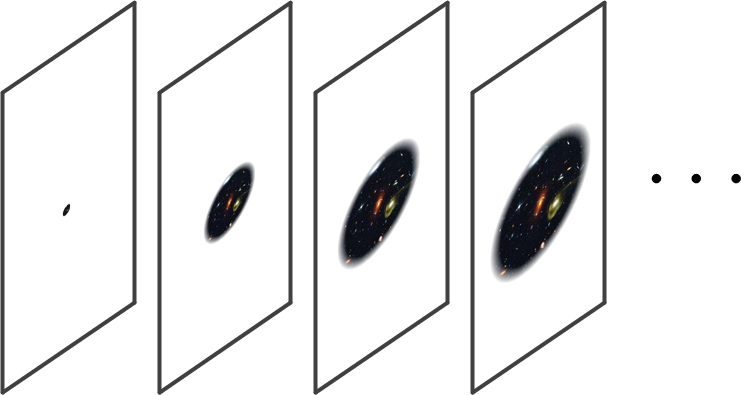In Part 1 of this series I have argued that since the universe is the entirety of space and time by definition, phrases like "outside the universe" carry no useful meaning. In this post I will examine a similar question that is also often brought up during ontological discussions.
What happened before the big bang?
Our daily lives are filled with processes that have temporal beginnings and ends. My morning journey to work, for instance, starts and ends at specific times which can be measured by specialized equipment such as clocks. If I leave to work at 8:00 AM and arrive at 8:30 AM then the temporal progression of my journey can be represented as a series of universe state "snapshots" that are taken at intermediate times between my departure to work and my arrival there.

Each snapshot of the universe state contains the states of all the physical systems in the universe at that moment. Any interesting state of a given system (for example, me walking though the door of my workplace) can be called an "event" and can be "timed". What we really mean by "timing" an event is that we specify the state of another physical system, typically a clock, in the same snapshot to which the event belongs. In other words, if I say that I enter work at 8:30 AM then this is really saying "the event of me entering work is contained within the same universe snapshot in which my watch points to 8:30 AM".
Events, therefore, can be timed only by referring to other events within the same universe state. It is tempting to consider whether there are alternative ways of timing events that do not involve referring to the state of other physical systems within the universe. This temptation is perhaps driven by the intuitive notion that time "keeps going" whether you’re looking at your watch or not. What this intuitive thought portrays is something like the following:

Here, our intuition is leading us to believe that our universe exists within a snapshot of a master universe which has its own time frame. Looks familiar? this is actually the same mistaken notion we encountered in Part 1 where our space was depicted as expanding into a container space. In this case, we’re supposing a "container time" to which we can tie events in our universe. This container time is encoded within a snapshot of the master universe in which our universe supposedly exists.
Of course it is logically possible that such is indeed the case. For example, assume that I run a simulation of a hypothetical universe in which a single universe state is represented by 1KB of memory. I can pick an initial state, formulate a set of physical laws of my choosing and compute the first 106 states of this universe. Now assume that intelligent beings emerge in this simulation and ponder the nature of time in their universe. They may postulate that their entire timeline is part of a snapshot of a master universe in which their own universe is realized. In this case their assumption will be correct; their entire timeline is indeed represented by 1GB of RAM in one snapshot of a master universe … ours!
This is a very amusing scenario which virtual reality enthusiasts might find particularly appealing. Alas it doesn’t actually help us in establishing an external time reference for our universe because it only shifts the problem to finding an external time reference for the master universe (see Begging the Question).
We are now in a position where we are ready to answer the question "what happened before the big bang?". To do this we make use of our snapshot notation again to see what predates the big bang. We slice up the timeline of our universe and a problem becomes immediately obvious …

The big bang snapshot is the first in the series.
How can this be? Well, the big bang is defined as the first moment in our timeline and so prior snapshots cannot exist by definition.
If your intuition is still trying to push you to speculate prior-bang moments then this is a good time to take a break. Speculating the existence of prior-bang universe snapshots requires the existence of an external time reference in a master universe which, as we explained previously, doesn’t solve the problem but moves it to another location.
But what if the first snapshot was "hanging there" for sometime before the big
bang occurred? For example if the first snapshot was at t=0, the second at
t=1 seconds and so on then couldn’t the first snapshot (the initial state of
the universe) have existed from t=-infinity up to t=0 at which time the
big bang occurred? If you think about it carefully, you may notice that this
line of reasoning falls victim to the same mistake of assuming an external
time reference according to which these snapshots are timed. In reality, time
measurement, beginnings and ends are notions that exist only within the
snapshots and not outside them.
We can now state our conclusion. The phrase "before the big bang" does not refer to anything meaningful and is devoid of meaning just as its sister "outside the universe" and other similar intuition traps.
When we say "everything has a beginning" we should pay careful attention not to include time as a "thing". The statement is better stated as "the beginning of every physical process can be specified by stating the corresponding state of a clocking device in the same universe state snapshot". Time, however, is not a physical process and has no beginning.